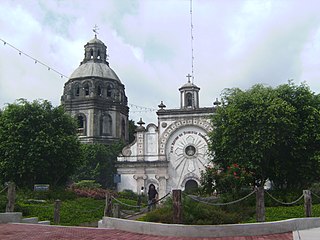
Pampanga, officially the Province of Pampanga, is a province in the Central Luzon region of the Philippines. Lying on the northern shore of Manila Bay, Pampanga is bordered by Tarlac to the north, Nueva Ecija to the northeast, Bulacan to the east, Manila Bay to the central-south, Bataan to the southwest and Zambales to the west. Its capital is the City of San Fernando. Angeles City is the largest LGU, but while geographically within Pampanga, it is classified as a first-class, highly urbanized city and has been governed independently of the province since it received its charter in 1964.

Candaba, officially the Municipality of Candaba, is a 1st class municipality in the province of Pampanga, Philippines. According to the 2020 census, it has a population of 119,497 people.

Kapampangan, Capampáñgan, or Pampangan is an Austronesian language, and one of the eight major languages of the Philippines. It is the primary and predominant language of the entire province of Pampanga and southern Tarlac, on the southern part of Luzon's central plains geographic region, where the Kapampangan ethnic group resides. Kapampangan is also spoken in northeastern Bataan, as well as in the provinces of Bulacan, Nueva Ecija, and Zambales that border Pampanga. It is further spoken as a second language by a few Aeta groups in the southern part of Central Luzon. The language is known honorifically as Amánung Sísuan.

The University of Santo Tomas, officially the Pontifical and Royal University of Santo Tomas, Manila or colloquially as USTé, is a private, Catholic research university in Manila, Philippines. Founded on April 28, 1611, by Spanish friar Miguel de Benavides, third Archbishop of Manila, it has the oldest extant university charter in Asia and is one of the world's largest Catholic universities in terms of enrollment found on one campus. It is the main campus of the University of Santo Tomas System that is run by the Order of Preachers.

Angeles, officially the City of Angeles, is a 1st class highly urbanized city in the Central Luzon region of the Philippines. According to the 2020 census, it has a population of 462,928 people.

Malolos is the historical site of the constitutional convention of 1898 that led to the establishment of the First Philippine Republic, led by Emilio Aguinaldo. Malolos was the site of the constitutional convention of 1898, known as the Malolos Convention, that led to the establishment of the First Philippine Republic, at the sanctuary of the Barasoain Church. The convent of the Malolos Cathedral served as the presidential palace at that time.

Mabalacat, officially Mabalacat City, is a 3rd class component city in the province of Pampanga, Philippines. According to the 2020 census, it has a population of 293,244 people.

San Antonio, officially the Municipality of San Antonio, is a 1st class municipality in the province of Nueva Ecija, Philippines. According to the 2020 census, it has a population of 83,060 people.

San Fernando, officially the City of San Fernando, is a 1st class component city and capital of the province of Pampanga, Philippines. According to the 2020 census, it has a population of 354,666 people.

Bacolor, officially the Municipality of Bacolor, is a 3rd class municipality in the province of Pampanga, Philippines. According to the 2020 census, it has a population of 48,066 people.

Magalang, officially the Municipality of Magalang, is a 1st class municipality in the province of Pampanga, Philippines. According to the 2020 census, it has a population of 124,188 people.

Mexico, officially the Municipality of Mexico, is a 1st class municipality in the province of Pampanga, the Philippines. According to the 2020 census, it has a population of 173,403 people. It was also formerly known as Nuevo México during the Spanish period.

Minalin, officially the Municipality of Minalin, is a 4th class municipality in the province of Pampanga, Philippines. According to the 2020 census, it has a population of 48,380 people.

Santo Tomas, officially the Municipality of Santo Tomas, is a 4th class municipality in the province of Pampanga, Philippines. According to the 2020 census, it has a population of 42,846 people.
The Kapampangan people, Pampangueños or Pampangos, are the sixth largest ethnolinguistic group in the Philippines, numbering about 2,784,526 in 2010. They live mainly in the provinces of Pampanga, Bataan and Tarlac, as well as Bulacan, Nueva Ecija and Zambales.

Historical markers are installed by the National Historical Commission of the Philippines (NHCP) and its predecessor agencies in the Philippines and places abroad that signify important and historic events, persons, structures, and institutions. The commemorative plaques are permanent signs installed by the NHCP in publicly visible locations on buildings, monuments, or in special locations. The NHCP also allows local municipalities and cities to install markers of figures and events of local significance, although these markers are barred from using the seal of the Republic of the Philippines.

The Galeón: Manila–Acapulco Galleon Museum or the Museo de Galleon is a maritime museum under construction within the SM Mall of Asia complex in Pasay, Metro Manila, Philippines. The museum will feature Manila–Acapulco galleon trade and will also house a full-scale replica of a Galleon within its interior.

The Pamintuan Mansion is a historic building in Angeles City, Philippines built by the Pamintuan family in the 1880s. It was briefly used by the Katipunan during the Philippine-American War. It currently hosts a social science museum.

Metro Clark, also known as Metro Angeles or Metro Clark Angeles, is an urban area in Pampanga, in Central Luzon, Philippines. It is primarily composed of three cities and further supported by 9 municipalities. Its urban core consists of the cities Angeles, San Fernando and Mabalacat. It is a major urban area of the Philippines and is considered the industrial and residential center of Central Luzon.

The Shoe Museum is a museum in Marikina, Metro Manila, Philippines.






















